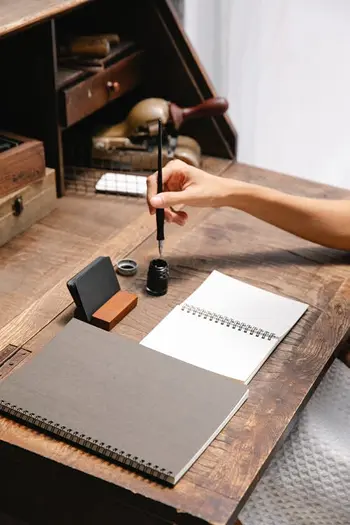Have you ever asked yourself, “Who invented ink?” Yeah, me neither, at least not until I read that ink can be dated back to around 3000 BC. Who would have thought? It’s one of those things we take for granted every day. So, who invented ink?
One of the oldest known inks was found in Ancient Egypt, on a piece of papyrus, where the black pigment was mixed with the oil of cedar terebinth and gum, now dated back to 3000 B.C.
In this post, I’m going to present to you how people created ink before the invention of synthetic materials. Let’s find out more about it!
Also Read: https://nevadainventors.org/who-invented-eraser/
Who Invented Ink?

Inking is the process of applying ink to paper, canvas, or other suitable material.
Ink is a liquid that contains pigments and/or dyes and/or other materials to color the base material.
When you think of who invented ink first, you have to go back to the early days of our civilization.
Ink is thought to have been invented by the ancient Egypt people in about 3000 BC.
They made a black dye called kohl by mixing soot with gum arabic, which they used to paint their faces and inscribe on papyrus.
However, this substance wasn’t meant for writing but to prevent the aging and decay of papyrus scrolls.
The Egyptians also used a similar black substance called “lampblack” as a cosmetic, which they applied to their faces and bodies to protect them from the sun’s harmful rays.
The ancient Chinese were also known to use ink, although it’s not clear exactly when they started using it. The earliest evidence of ink comes from markings on pottery from around 1500 BC.
But it was probably being used much earlier than that.
Chinese ink was made from lampblack (soot) mixed with glue, then painted on a piece of paper or silk to form characters or images.
Who Invented Ink Pen?
The earliest known ink pen was invented by the Chinese in the fourth century B.C. The Chinese also used this pen to write on silk and paper.
Ink pens in Europe were first used around the tenth century A.D. when they were introduced by Arab traders.
The Europeans called these pens “feather pens” because they were made from goose feathers.
Europeans later used quills (usually from geese) as writing tools until the eighteenth century, when metal nibs replaced them.
The first American patent for an ink pen was issued in 1809 to John Scheffer of New York City for his invention of a self-filling fountain pen that he called a “pelican.”
Who Invented Ink Tank Printer?
Inkjet printers that use ink cartridges have been around since the 1980s. In contrast, ink tank printers are more recent developments.
The first ink tank printer was invented by Epson in 1991, but the technology has improved over time to become much more reliable and cost-effective.
Inkjet printers use a series of tiny nozzles to spray the ink onto paper. The nozzles can only be used once before they need to be replaced with new ones.
This means that it is expensive to produce these printers because you have to manufacture and ship large numbers of replacement parts for every printer sold, which can add significantly to the price tag.
Who Invented Ink Painting?
Ink painting is a traditional Chinese art form that dates back to the Shang Dynasty (c. 1600–1046 BCE).
It was originally used as a funerary practice, but by the Han Dynasty (206 BCE–220 CE) it had become popular among the elite classes, who commissioned artists to create works of art for their enjoyment.
It was during the Tang Dynasty (618–907) that ink painting became a major form of Chinese painting and began to influence Japanese painting.
This influence was so great that Japanese painters began using Chinese ink techniques in their work.
From this point onward, ink paintings were used as expressions of high culture and sophistication in both China and Japan.
Who Invented Quink Ink?
The first recorded use of quink as a new type of ink was made by the American inventor Francisco Quisumbing in 1856.
Quisumbing, who was also known as Franciso Quisumbing, was born in 1822 in Manila and studied medicine at the University of Santo Tomas. He also taught medicine at the same university.
Quisumbing had previously invented an improved method of making soap and another method for making candles.
However, his most important invention was a new type of ink called quink which he patented on April 6th, 1860.
Who Invented Tattoo Ink?
The tattoo ink has been traced back to ancient Egypt invention. The Egyptians, who were some of the first people to practice body art, made use of a type of tattoo ink called kohl.
This was a dark-colored substance used as eye makeup that also made up part of their mummification rituals
The tattoos were created using sharpened pieces of bone or copper, which were dipped into soot and ground vegetable dyes.
Who Invented Black Ink?

Black ink is the main color that a lot of people worldwide use to write on their written documents, whether it’s magazines, newspapers, or books.
The ink is made up of coal tar which makes it completely black. The ancient Egyptians invented black ink.
They mixed carbon, lampblack, and gum to create a substance that was as black as tar.
Black ink was made from carbon, which they discovered by burning things such as bones, wood, or straw and observing how much it changed their color.
Do you know who invented slime? Let’s find out: https://nevadainventors.org/who-invented-slime/
When Was Ink Invented?
The history of ink is a long one. It’s hard to tell what year was ink invented, but we can trace its origins back to around 3000 BC.
The Egyptians were the first people to use ink, which they made out of carbon-based materials like soot, lampblack, and gum tragacanth.
They would use these materials in combination with water, either by mixing them or dipping their pens into the mixture.
Ink has been used by humans ever since then. The Greeks used a similar ink that was made from soot mixed with vinegar and gum.
They also used this mixture for writing as well as painting on walls.
When Was Invisible Ink Invented?
Invisible ink was invented in the early 19th century. It was used to write secret messages and then reveal them using a chemical reaction, or with heat from a candle or flame.
Invisible ink was often used by spies during wartime, but it has also been used for more innocent purposes.
The first known use of it was by two German scientists who used an acidic solution of iodine and potassium iodide to write secret messages on paper.
The idea caught on quickly, and soon people were using invisible ink to write secret letters, send coded messages during wars, and even write secret messages on money!
When Was Colored Ink Invented?
The invention of colored ink is a bit of a mystery. It’s believed that the first ink was made from soot and water, but it’s unclear as to when this occurred.
The Chinese were the first to make use of what we call colored ink: they used it to paint paper and silk. They also used it for calligraphy and painting.
They were the first ones to make use of all different colors, including green, red, blue, and black.
Colored inks were invented in the Middle Ages. However, they weren’t widely used until much later (about 400 years later).
When Was Blue Ink Invented?
Blue ink was first used in Europe during the Renaissance when people were starting to use pens and quills instead of reed pens.
The first blue ink was made from indigo and copperas, which is also known as ferrous sulfate or iron(II) sulfate.
In the 16th century England, blue ink was made by adding copper to an iron gall ink.
The first synthetic dye for producing blue inks was Prussian blue, discovered by accident by chemist Christian Schönbein in 1704 while trying to make purple dye out of green vitriol (ferrous sulfate).
When Was Red Ink Invented?
Red ink has been used since ancient times. In China, red ink was first made from the soot of burnt bamboo.
In the West, red ink was made by mixing iron salts such as ferric oxide with water and gum arabic.
Ink is a pigmented or dyed liquid or pastes that is used to paint a surface to create an image, lettering, or pattern.
With a pen or brush, ink is used to draw or write. In typography and lithography, thinner inks in paste form are often employed.
When Was Tattoo Ink Invented?
The first recorded use of tattooing was by the ancient Egyptians, who used a mixture of soot and animal fats.
Soot was mixed with gum arabic (sap from the acacia tree), which made the ink more water soluble than pure soot.
In this way, they were able to draw symbols on their skin using sticks as needles.
Some historians believe that some forms of tattooing may have been practiced as early as 10,000 BC by peoples such as Australian aborigines, New Zealand Maori, and Polynesians living in Hawaii and New Zealand.
However, we have no written proof of this practice until 2000 BC when an Egyptian tomb painting showed two men with tattoos.
Where Was Ink Invented (Which Country Invented Ink)?
Ink has been around for thousands of years, but the first time it was ever recorded as being used was in ancient Egypt about 3,000 years ago.
The ancient Egyptians made and used a mixture of soot and gum to create their ink.
The Chinese also had an early form of ink that they made from pine soot mixed with glue from fish scales and animal hides.
The Japanese also used this kind of early ink in the 8th century A.D., although they also added watercolor to make it look more vibrant.
Types of Ink Today
There are three main types of ink today: dye, pigment, and water.
- Pigment-based ink – Pigment-based ink particles are heavier than dye-based ones, so they tend to sink deep into paper fibers. This makes them more resistant to water and light fading.
- Dye-based ink – This is another popular type of ink used for printing. Dye-based ink uses dyes instead of pigments as its coloring agent. Dyes are soluble in water, so they bleed when wet.
- Water-based ink – This is the newest type of ink available today because it’s environmentally friendly and doesn’t require any special disposal methods like other types of inks do.
Types of Ink for Printers
There are two main types of printers today: laser and inkjet.
Laser printers use toner cartridges, which are filled with tiny granules of ink.
The laser printer uses a fuser to melt the toner onto the page, and it may also use a transfer roller to move the toner from the cartridge to the paper.
Inkjet printers use ink cartridges that contain liquid ink. The printer’s print head heats up to about 300 degrees Fahrenheit and sprays tiny droplets of ink onto the page.
Some printers have more than one print head so they can print in color.
Types of Ink Cartridges
There are several different types of ink cartridges that you can use in your printer.
They come in a wide range of colors, sizes, and shapes, but the most common ones are inkjet and toner cartridges.
- Inkjet cartridges
These are the most common type of ink cartridges and they work by using tiny nozzles to spray the ink onto the paper.
The type of inkjet cartridge you use will depend on your printer model. Some printers can use more than one type of ink cartridge, while other printers only use one type.
- Toner cartridges
Toner cartridges are similar to inkjet cartridges as they also have a nozzle that sprays toner onto the paper as it passes through the printer.
However, instead of using liquid inks, toner cartridges use solid powder so they tend to be more reliable than liquid-based cartridges.
Types of Ink Pen
The type of ink pen is determined by its components. The ink pen is made up of several parts that include:
- Barrel: This part is where you place your hand when holding the pen. It also holds the refillable ink cartridge.
- Tip: The tip is where you write with your ink pen. Ink pens come in different nib sizes such as fine, medium, and broad nibs. Each type of nib has a different width at its tip and will produce different line widths when used on paper or other surfaces.
- Cap: Caps protect your pen’s tip from being damaged while not in use. They also prevent leaks from happening inside your barrel when it isn’t being used by keeping air out of it when capped up properly.
Types of Ink Used in the Printing Press
There are several types of ink used in the printing press. They are as follows:
- Oil-based ink is made from a substance called pigment. This pigment can be mixed with other substances to produce different colors or shades of color.
- Water-based ink dries more slowly than oil-based ink does, but it does not leave stains on paper as oil-based ink does.
- Solvent-based ink It is water-based and contains organic solvents like ethylene glycol, acetone, methanol, ethanol, or isopropyl alcohol.
- UV curing ink is also known as “curing” or “photosensitive” ink because it is sensitive to ultraviolet light.
Types of Ink for Art
The four main types of ink for art are:
- Acrylic ink – This type of ink is made with acrylic polymer emulsion, which makes it waterproof. It can be used on many surfaces such as paper, plastic, or canvas.
- Chinese ink – This type of ink requires a solvent like water or alcohol to dilute it before you can use it.
- Watercolor pencils – These pencils contain highly pigmented wax-based colors that mix well with water to create wash effects when applied with brushes or fingers.
- India-ink pencils – These pencils contain an oil-based formula that produces rich blacks when applied directly to paper without using any water at all!
Types of Ink for Stamps
There are many different types of ink for stamps. Ink for stamps can be water-based or oil-based.
Water-based inks are considered to be safer and easier to use, but oil-based inks are more permanent and offer better resistance to water and other liquids.
- Water-based inks are the most commonly used type of ink for stamps. They are generally safe to use and easy to clean up if spilled on clothing or paper.
- Oil-based inks are more permanent than water-based ones and don’t dry out as quickly when exposed to air or heat.
Types of Ink for Tattoos
All tattoo ink colors are based on 4 main types of ink for tattoos:
- Matt black – It’s more than just a simple black ink; this type of ink contains titanium dioxide to give it depth and opacity. This makes it great for shading and line work.
- Yellow – This is one of the most popular colors used in tattoos today because it allows artists to create bright, vibrant designs without having to mix other colors.
- Blue – Blue is another popular color that gives artists plenty of options for getting creative with their designs.
- Red – Red is commonly used for outlining because it’s easy to see against dark skin tones, but this type of ink can also be used for shading and highlighting as well!
Ink History Timeline
The history of ink goes back to 3000 BC when the Egyptians used soot as ink. They would mix soot with water and use reeds as pens.
The first recorded use of ink in China was around 1600 BC. Chinese ink was made from lampblack (soot), gelatin, glue, and tree gum.
The Greeks used carbon black for their writing material, which is a form of carbon that can be found naturally in coal or petroleum.
Carbon black is still commonly used today as a coloring agent in many different types of writing instruments.
India and China were also big contributors to the history of ink because they were the first countries to start using metal nibs instead of reeds when writing on papyrus or paper.
How Was Ink Made in the 1700s?
In the 1700s, ink was made from a mixture of lampblack (a fine black powder derived from burning oil) and gum arabic (a natural resin found in many plants).
Lampblack was mixed with water, then added to gum arabic and boiled overheat.
The mixture was poured into bottles to cool.
Inks were also made by mixing powdered charcoal or soot with linseed oil. Linseed oil is extracted from flax seeds and used as a drying agent in paints and varnishes.
How Was Ink Made in the 1800s?
The ink used in the 19th century was made by grinding together a variety of ingredients.
These included lampblack, gum Arabic, and shellac. Other ingredients included logwood and iron sulfate.
The ink was sold in both dried and liquid forms.
The liquid form could be diluted with water to make a thinner ink or mixed with alcohol to make a waterproof ink that was suitable for writing on damp paper or vellum.
Lampblack is produced from the incomplete combustion of oil or coal, which leaves behind soot particles that are then ground into a powdery substance called lampblack.
Lampblack is still used today in artists’ paints and inks.
Who Invented Ink in Ancient Egypt?
The Ancient Egyptians were not only the first civilization to invent writing, but they were also the first to invent ink.
The Ancient Egyptians used black ink made from carbon and water to write on papyrus, which they made from reeds. In ancient Egypt black ink was pricey.
The Ancient Egyptians also used paint rather than ink for drawing images and inscriptions on walls.
They made their paint by mixing red lead oxide with animal fat or vegetable oil and heating them together at high temperatures until they became liquid.
Then they poured the mixture into pots and left it to cool down completely before using it as paint.
Among all ancient Egypt inventions, this one was spread the most worldwide.
Who Invented Ink in Ancient China?
The Han Dynasty (206 BCE-220 CE) is considered the golden age of Chinese history.
During this time, there were many advancements in technology, including the invention of ink.
The Han Dynasty is widely considered to be one of the most influential periods in Chinese history.
This period was marked by great political, social, and economic change, and it was during this time that many key inventions were made.
The ink was created as an attempt to make a substance that could be used for writing on silk or paper.
The Han Dynasty was also famous for its advancements in papermaking, which led to better methods for making ink.
Who Invented Ink in India?
Ink is the liquid or pastes used to write and draw with a pen, brush, or quill.
India is one of the oldest countries in the world. It has been known for its culture, art, and architecture.
Ink is made from different materials such as soot, iron gall ink, shellac, and iron salts. Soot was used as ink in India before the arrival of paper.
India’s first ink was also made from the soot of palm leaves, charcoal, and natural resins.
FAQs
There are many frequently asked questions about who invented ink, so I’m pointing out just some of them.
What was ink originally made from?
The ink was originally made from a mixture of soot, gum, and water. Soot was collected from burning candles and torches, which left behind a dark residue.
What are the four types of ink?
The four types of ink are 1. Dye-based inks; 2. Pigment-based inks; 3. UV-resistant ink; 4. Waterproof ink
What are the 3 main components of ink?
The three main components of the ink are the solvent (the liquid that carries the other two components into a mixture); the pigment (what gives ink its color, and it’s often made from minerals or metals); and the binder (used to keep pigment and solvent together in a liquid form until they are applied to paper or other surfaces).
What does hybrid ink mean?
Hybrid ink means that the ink is a combination of two or more colors. It can be used to create a wide range of colors, depending on the number and kind of colors that are combined.
Is ink made from squid?
Writing ink isn’t made from squid. Squid ink is typically made from sepia, which is the edible brown ink that squids produce to blend in with their surroundings and hide from predators.
Conclusion
In conclusion, I believe that the Egyptians were the first to invent ink. This conclusion is based on their written language, which was a pictorial one and therefore required a way to create images.
The Egyptians also had access to different materials than other people at the time, as they lived in an area where there was much more plant life.
But if you still have doubts and questions about who invented ink, feel free to leave us a comment.

